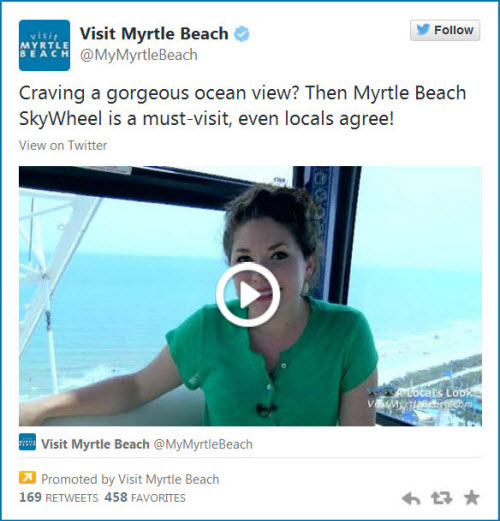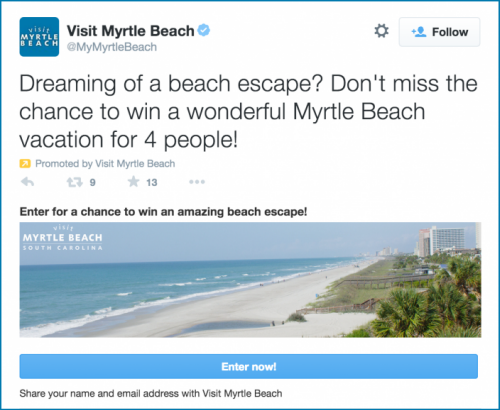by
Courtney Eckerle, Manager of Editorial Content
THE CUSTOMER
With an objective to share the draw and attractions of Myrtle Beach, S.C., to encourage people into visiting, Scott Schult, Executive Vice President of Marketing, Myrtle Beach area Chamber of Commerce, knew they needed a visual and engaging strategy.
The emphasis was to drive visitors to the Visit Myrtle Beach website, "so we wanted something that could stimulate awareness and interest," he said. The marketing team turned to Twitter.
CHALLENGE
"We were starting to have very good successes with some other social platforms, but we really had quite frankly neglected and underutilized Twitter as a means to stimulate tourism interest for our destination," said Schult.
To correct this, Visit Myrtle Beach decided to be one of the first destinations to move forward on testing some of Twitter’s new advertising products — namely, video Cards. Video Cards allow Twitter users to view a video in one tap, attached to a tweet.
"Our objectives here were really pretty clear. You know, with everything we’re doing in the social space, with every platform we’re looking at, you really want to grow brand awareness and desirability to visit the destination. And we wanted to grow that specifically among the Twitter-sphere," he said.
CAMPAIGN
While taking a risk on a new form of Twitter advertising was an investment for the team, they felt it was worthwhile, Schult said.
"It was … a great learning experience for us to really have some of the internal, professional insights from those inside Twitter because they also put a little skin in the game and also provided us with some insight along with visibility and conversions in order to really optimize and move forward," said Schult.
The team wanted to ramp up their Twitter marketing with a focused, two-month campaign that started on May 15 and ended on July 15, 2014.
The team started about a week before the launch, creating about 10 initial campaigns to go along with the ad products they were starting on Twitter.
After the launch of the campaign, they added a few more products and additional campaigns. They ended up with 27 campaigns.
"We continued to evolve as the campaign went forward. And pretty much, when we got toward the completion of the campaign, of course along the way were doing some optimization, but then we had a complete evaluation and analysis," he said.
Step #1. Begin targeting the core audience
"We created over 10 different campaigns that were really focused on several key audience segments. When we first started off, we were a family destination, and so we were highly targeting families and women with children as our initial start. So really moms," Schult said.
From there, the team branched out to country music fans, which the team knew aligned with their audience of NASCAR fans. Also, they targeted outdoor enthusiasts and craft beer fans.
"There were some synergies there with trying to do those targeted audience efforts," he said.
Most of the campaigns launched were Promoted Tweets, which showcased the destination while trying to encourage Twitter users to engage in Visit Myrtle Beach messaging as well as serve the objective of driving them back to the website.
At that point, the team moved toward keyword targeting to follow on the growth of those campaigns, Schult said.
"We tried to look at those folks who were looking for keywords that aligned with our destinations, such as people looking for a beach vacation," he said.
Step #2. Create clickable elements
The team moved quickly into creating engaging video Cards that contained clickable video to drive people back to the website.
"We’re a very big proponent of customized videos and using video as the inspiration to get people inspired and to consider the destination for our perspective visits. So we were happy once that product came online," Schult said.
The team wanted to leverage the new feature because "that’s really in our wheelhouse. We move so much of our content creation and sharing around video," he said, adding that with multiple video platforms, the team can do a lot with customizing video for each platform.
"Anything we can use that has a video as part of the delivery mechanism is something that we’re very bullish on … as a destination, that’s the best way that we can draw and emotional connection with people and get them inspired and interested in coming to our destination," Schult said.
The idea behind pushing videos is that when users are planning vacations, they like to see a sneak peek of local attractions. @MyMyrtleBeach used video Cards to share a video series called "
A Local’s Look" in which hosts featured breweries, restaurants, baseball games and car racing events.

Click here to see the full version of this creative sample
"Anything that helps better target our prospective customer and utilize video to inspire and create demand is something that we’re going to try. If it doesn’t work, if it doesn’t work on a certain platform or a certain product, we will move on quickly from that. I mean, that’s the best thing about being able to gauge the effectiveness really quickly using anything digital," he said.
The video Cards had an engagement rate between 3 to 5%, which was higher than average @MyMyrtleBeach engagement of around 1.5%.
"When that’s targeted appropriately, that just makes our investment turnout to be that much more effective and efficient because we can’t be everyone at all times … we also need to make sure that people are utilizing it and that it’s relevant," he said.
Step #3. Coordinate tweets with relevant events
The team progressed through the different advertising elements and found that "we ended up with … 27 total campaigns. And one of the areas that we found some good success, and I think this is relevant for other destinations specifically, is we started to see really good response around event-related tweets," Schult said.
When certain events were happening in Myrtle Beach, "we’re pushing that out, and we had some really good responses. We had 'American Idol' that was coming to town to do some auditions, and some Fourth of July events," he said.
As the team was sending out event-related tweets, the team saw stronger engagement. As they were discovering these tweets to be of greater interest to their audience, they started to promote even more summer events, such as car and stunt shows.
Focus on giveaways
Perhaps the most successful component of Visit Myrtle Beach’s recent campaign was its "Dream Escape" giveaway, according to Schult.
The brand offered to give the winning user, alongside three friends or family members, a three-night stay at a Myrtle Beach area resort. The giveaway was promoted exclusively on Twitter, using Lead Generation cards, and resulted in 7,089 entries.
The giveaway was promoted on Twitter using
Lead Generation cards, which allow Twitter users to click on an expanded tweet and enter, without leaving Twitter. The cards featured a picture of Myrtle Beach and invited users to "Enter now!" by giving their user name and email address.

Click here to see the full version of this creative sample
RESULTS
Even though social media is perhaps simpler than some other platforms, Schult said it would be a mistake to dismiss it as easy.
"You cannot set it and forget it. It takes active management if you’re going to generate the results that you want. And you have to constantly be optimizing and enhancing what you’re doing in order to get the performance that you desire. That’s what we do with everything," he said.
With Twitter specifically, he added the team saw the need to "move the needle" in a couple of core areas, and they will be utilizing the platform as a staple of their social media strategy going forward.
The results they were able to achieve through this focus on Twitter were:
- Video Cards received an engagement rate of 3 to 5%, compared to 1.5% for regular tweets
- Followers grew by 11k over 2.5 months
- Twitter Video Cards provided a 225% overall lift in video views
- Lead Generation cards yielded a CPA 30% lower than anticipated
"This was another example whereby once we got into different product capabilities, we were able to manage those effectively to produce results. And as we continued to manage these in real time, we did get better and better with the performance of them," Schult said.
Creative Samples
- Video Cards
- Lead Generation cards
Sources
Visit Myrtle BeachRelated Resources
User-generated Content: 15% lift in site traffic for Mizzou Alumni Association using image galleries 4 Tips from Jonah Berger on Taking Content Marketing ViralInbound Marketing: 450% average ROI from Facebook advertising and organic content effort Social Media Marketing: Boston Marathon sponsor John Hancock brings together 30 thousand people with mosaic campaign










